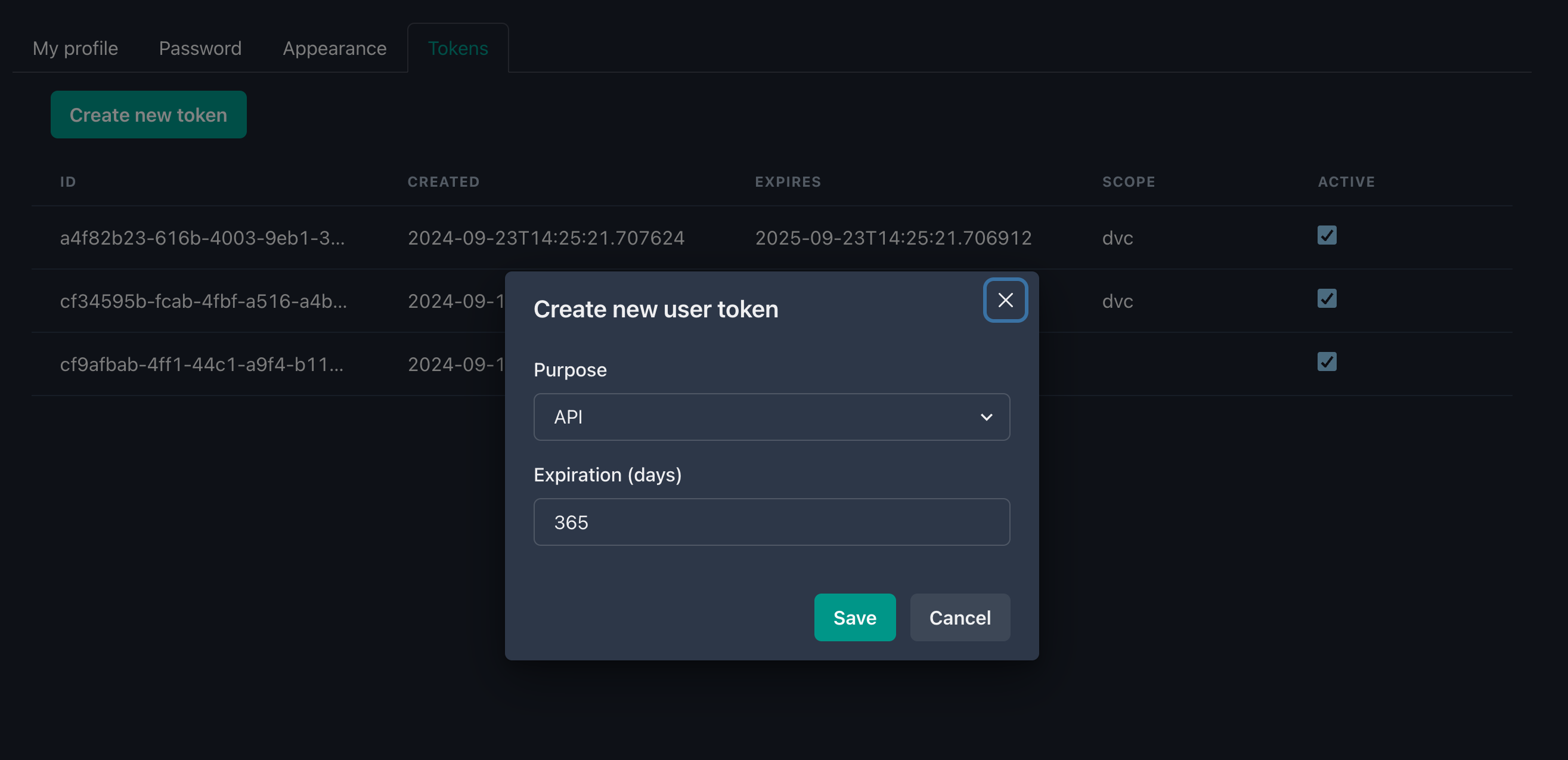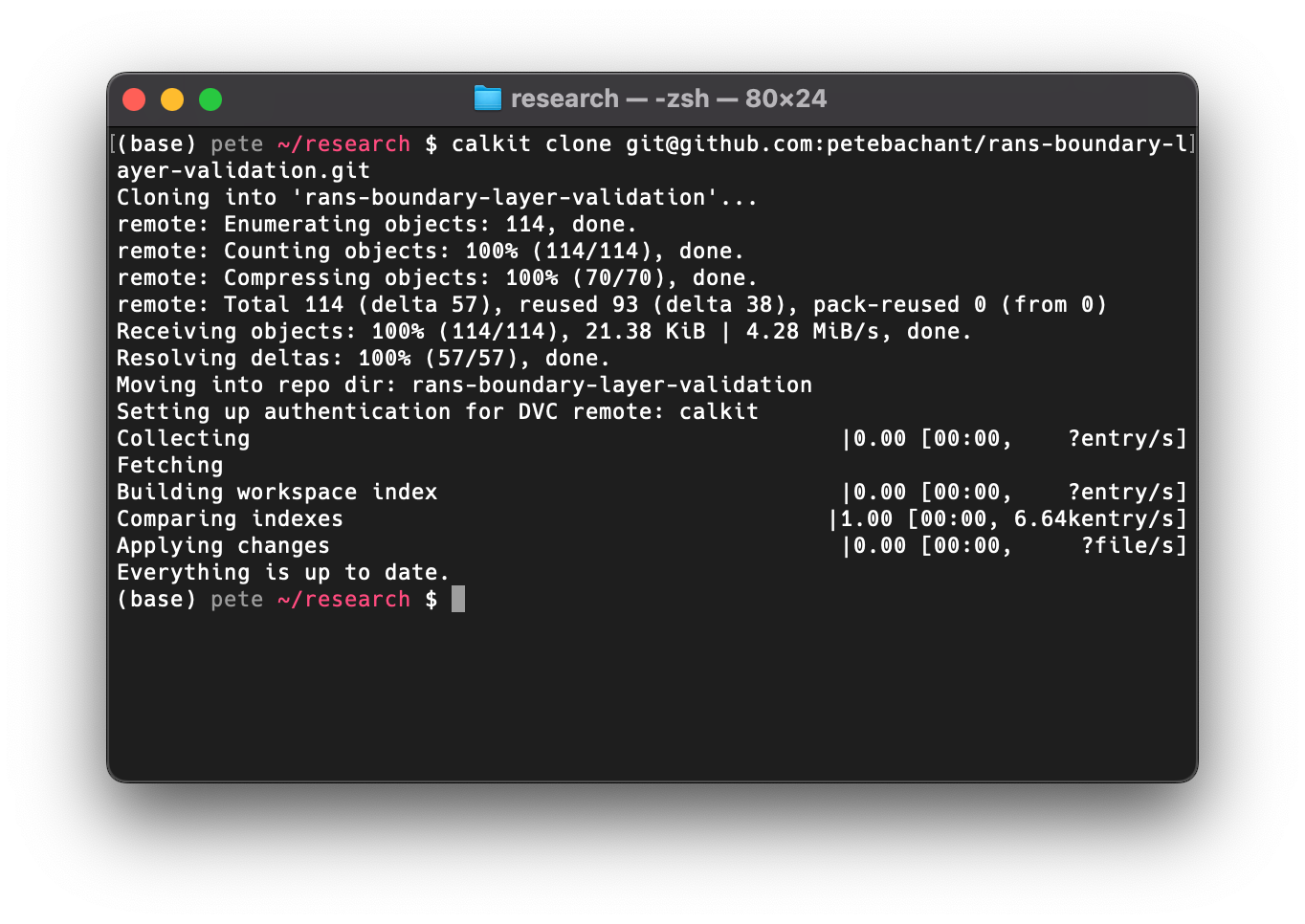-
October 23, 2024
Reproducible OpenFOAM simulations with Calkit
Have you ever been here before? You’ve done a bunch of work to get a simulation to run, created some figures, and submitted a paper to a journal. A month or two later you get the reviews back and you’re asked by the dreaded Reviewer 2 to make some minor modifications to a figure. There’s one small problem, however: You don’t remember how that figure was created, or you’ve upgraded your laptop and now the script won’t run. Maybe you were able to clone the correct Git repo with the code, but you don’t remember where the data is supposed to be stored. In other words, your project is not reproducible.

Here we are going to show how to make a research project reproducible with Calkit, a tool I’ve been working on that ties together and simplifies a few lower-level tools to help with reproducibility:
- Git
- GitHub
- DVC (Data Version Control)
- Docker
- Cloud storage
We’re going to use OpenFOAM and Python to generate our outputs since these both can be pretty tricky to get setup correctly, never mind setup correctly twice!
Getting setup
You will need to have Git installed, and you’ll need to have a GitHub account. You’ll also need to have Python (Mambaforge recommended) and Docker installed. After that, install the Calkit Python package with:
pip install calkit-python
Creating and cloning the project repo
Head over to calkit.io and log in with your GitHub account. Click the button to create a new project. Let’s title ours “RANS boundary layer validation”, since for our example, we’re going to create a project that attempts to answer the question:
What RANS model works best for a simple boundary layer?
We’ll keep this private for now (though in general it’s good to work openly.) Note that creating a project on Calkit also creates the project Git repo on GitHub.

We’re going to need a token to interact with the Calkit API, so head over to your user settings, generate one for use with the API, and copy it to your clipboard.

Then we can set that token in our Calkit configuration with:
calkit config set token YOUR_TOKEN_HERENext, clone the repo to your local machine with (filling in your username):
calkit clone https://github.com/YOUR_USERNAME/rans-boundary-layer-validation.gitNote you can modify the URL above to use SSH if that’s how you interact with GitHub.

calkit cloneis a simple wrapper aroundgit clonethat sets up the necessary configuration to use the Calkit Cloud as a DVC remote, the place where we’re going to push our data, while our code goes to GitHub.Getting some validation data
We want to validate these RANS models, so we’ll need some data for comparison. It just so happens that there is already a boundary layer direct numerical simulation (DNS) dataset on Calkit downloaded from the Johns Hopkins Turbulence Databases (JHTDB), so we can simply import that with (after
cding into the project directory):calkit import dataset \ petebachant/boundary-layer-turbulence-modeling/data/jhtdb-transitional-bl/time-ave-profiles.h5 \ data/jhtdb-profiles.h5If we run
calkit statuswe can see that there is one commit that has been made but not pushed toorigin/main(on GitHub), so we can make sure everything is backed up there withcalkit push.
calkit statusandcalkit pushbehave very similarly togit statusandgit push. In fact, those commands are run alongside some additional DVC commands, the importance of which we will see shortly.We can now see our imported dataset as part of the project datasets on the Calkit website. We can also see the file is present, but ignored by Git, since it’s managed by DVC. Because the dataset was imported, it does not take up any of this project’s storage space, but will be present when the repo is cloned.

Creating a reproducible OpenFOAM environment with Docker
If you’ve never worked with Docker, it can sound a bit daunting, but Calkit has some tooling to make it a bit easier. Basically, Docker is going to let us create isolated reproducible environments in which to run commands and will keep track of which environments belong to this project in the
calkit.yamlfile.Let’s create an OpenFOAM-based Docker environment with:
calkit new docker-env \ --name foam \ --image openfoam-2406-foampy \ --from microfluidica/openfoam:2406 \ --add-layer miniforge \ --add-layer foampy \ --description "OpenFOAM v2406 with foamPy."This command will create the necessary Dockerfile and add the environment to our project metadata. The environment will be automatically created or updated as necessary when a command is executed in this environment.
If we run
calkit xenv -- blockMesh -help, the Docker image build be built and we’ll see the help output fromblockMesh. Running this command again will not kick off a rebuild unless the Dockerfile is modified.You’ll notice there is a new
Dockerfile-lock.jsonfile in the repo, which is how Calkit determines if the image needs to be rebuilt. We should now commit and push this file to the cloud so it is backed up and accessible to our collaborators. We can do this with thecalkit savecommand:calkit save Dockerfile-lock.json -m "Add Docker lock file"which does the
add,commit,pushsteps all in one, deciding which files to store in DVC versus Git, and pushing to the respective locations to save time and cognitive overhead. However, if desired, you can of course run those individually for full control.Now we’re good to go. We didn’t need to install OpenFOAM, and neither will our collaborators. We’re now ready to start setting up the cases.
Adding the simulation runs to the pipeline
We can run things interactively and make sure things work, but it’s not a good idea to rely on interactive or ad hoc processes to produce a permanent artifact. Any time you get to a point where you do want to save something permanent, the pipeline should be updated to produce that artifact, so let’s add some simulation runs to ours.
We want to run the simulation to validate a few different turbulence models:
- Laminar (no turbulence model)
- $k$–$\epsilon$
- $k$–$\omega$
I’ve setup this project to use foamPy to create and run variants of a case with a “templatized”
turbulencePropertiesfile via a scriptrun.py, which we’re going to run in our Docker environment.To simulate the same case for multiple turbulence models, we’re going to create a “foreach” DVC stage to run our script over a sequence of values. When setup properly, DVC will be smart enough to cache the results and not rerun simulations when they don’t need to be rerun. We can create this stage with:
calkit new foreach-stage \ --cmd "calkit xenv python run.py --turbulence-model {var} -f" \ --name run-sim \ --dep system \ --dep constant/transportProperties \ --dep run.py \ --dep Dockerfile \ --out "cases/{var}/postProcessing" \ "laminar" "k-epsilon" "k-omega"Another call to
calkit statusshows our pipeline needs to be run, which makes sense, so let’s give it anothercalkit run. You’ll note at the very start our Docker image build stage is not rerun thanks to DVC tracking and caching the inputs and outputs.The output of
calkit statusnow shows something we haven’t seen yet: we have some new data produced as part of those simulation runs. We can do anothercalkit saveto ensure everything is committed and pushed:calkit save -am "Run simulations"In this case, the outputs of the simulations were pushed up to the DVC remote in the Calkit Cloud.
We are defining an output for each simulation as the
postProcessingfolder, which we will cache and push to the cloud for backup, so others (including our future self), can pull down the results and work with them without needing to rerun the simulations. We are also defining dependencies for the simulations. What this means is that if anything in thesystemfolder, therun.pyscript,constant/transportProperties, or our Dockerfile changes, DVC will know it needs to rerun the simulations. Conversely, if those haven’t changed and we already have results cached, there’s no need to rerun. This is nice because to produce our outputs we basically only need to remember one command and keep running it, and that’s simplycalkit run, which is a wrapper arounddvc reprothat parses some additional metadata to define certain special objects, e.g., datasets or figures.Creating a figure to visualize our results
We want to compare the OpenFOAM results to the DNS data, for which we can plot the mean streamwise velocity profiles, for example. We can create a new figure with its own pipeline stage with:
calkit new figure \ figures/mean-velocity-profiles.png \ --title "Mean velocity profiles" \ --description "Mean velocity profiles from DNS and RANS models." \ --stage plot-mean-velocity-profiles \ --cmd "calkit xenv python scripts/plot-mean-velocity-profiles.py" \ --dep scripts/plot-mean-velocity-profiles.py \ --dep data/jhtdb-profiles.h5 \ --deps-from-stage-outs run-simThe last line there is going to automatically create dependencies based on the outputs of our
run-simstage, saving us the trouble of typing out all of those directories manually.Another call to
calkit statusshows we need to run the pipeline again, and another call tocalkit runthencalkit save -m "Run pipeline to create figure"will create this figure and push it to the repo. This figure is now viewable as its own object up on the website:
Solving the problem
Now let’s show the value of making our project reproducible, addressing the problem we laid out in the introduction, assuming Reviewer 2’s request was something like:
The legend labels should be updated to use mathematical symbols.
We’re going to pretend we were forced to start from scratch, so let’s delete the local copy of our project repo and clone it again using same
calkit clonecommand we ran above.
After moving into the freshly cloned repo, you’ll notice our imported dataset, the
cases/*/postProcessingdirectories, and our figure PNG file were all downloaded, which would not have happened with a simplegit clone, since those files are kept out of Git.Running
calkit statusandcalkit runagain shows that what we’ve cloned is fully up-to-date.Next we edit our plotting script to make the relevant changes. Then we execute
calkit run. Again, notice how the simulations were not rerun thanks to the DVC cache.If we run
calkit statuswe see there are some differences, so we runcalkit save -am "Change x-axis label for reviewer 2"to get those saved and backed up. If we go visit the project on the Calkit website, we see our figure is up-to-date and has the requested changes in the legend. Reviewer 2 will be so happy 😀
Conclusions and next steps
We created a project that runs OpenFOAM simulations reproducibly, produces a figure comparing against an imported dataset, and ensures these are kept in version control and backed up to the cloud. This is of course a simplified example for demonstration, but you could imagine expanding the pipeline to include more operations, such as:
- Running a mesh independence study.
- Building a LaTeX document as a report or paper.
Since DVC pipelines can run any arbitrary command, you’re not locked into a specific language or framework. You could run shell scripts, MATLAB programs, etc., all in a single pipeline.
You can view this project up on Calkit and GitHub if you’d like to get started doing something similar. Also, please comment below if you’re using a different tool or framework to make your own work reproducible.
-
January 02, 2020
Diesel Explorer: Sold
In the spring of 2019, after roughly 11 years and 80,000 miles of operation, I decided to sell the Diesel Explorer. It was hardly being driven since moving to Boston from Michigan, and I figured it would be better to find a new home where it could be put to good use. The eBay listing caught the attention of some Cummins diesel enthusiasts out west, and shortly thereafter, the Explorer’s new owner flew out to Boston and drove it all the way back to Montana, picking up a boat in Minnesota along the way.
At its core, the goal of this project was to reduce my energy consumption. From my records, I saved about $4,000 in fuel, which equates to roughly 24,000 lbs of CO2.
However, that initial guiding principle remained, and the concept of using a bicycle for transportation kept emerging in my head as a better solution. I bought my first road bike in grad school, after seeing one of my lab mates commute on one year-round (in New Hampshire.) Seeing someone ride a bike in the winter was a bit of a shock at first, until realizing that people do plenty of other activities outdoors in the winter, e.g., skiing, sledding, snowshoeing, walking. It also began to feel more and more wasteful and impractical to move around 4,000 lbs of heavy machinery with me every day simply so I could live farther away from the places I needed to go.
I’m not sure where the path towards energy efficiency will lead next, but it will most likely be traveled by bicycle.